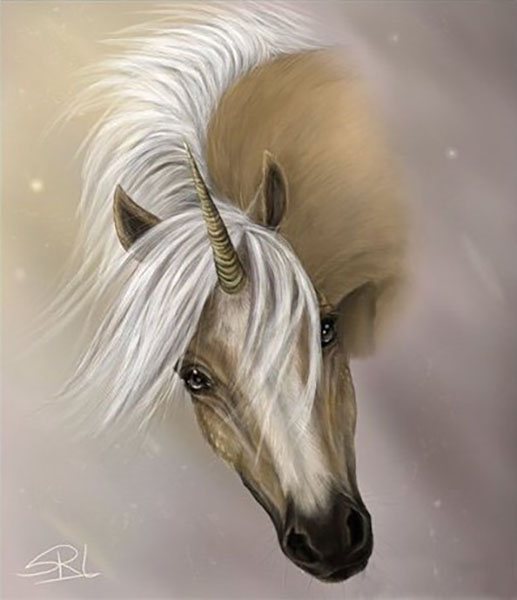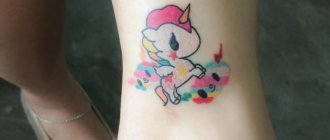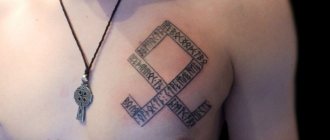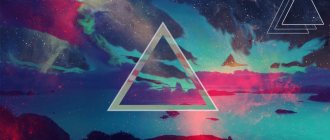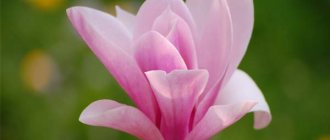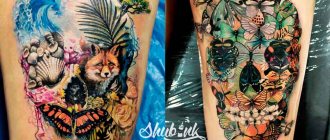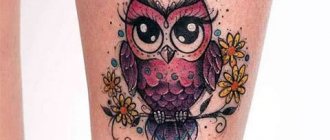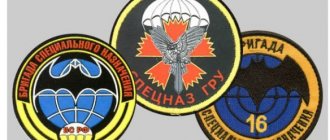The Unicorn is a mysterious and mythical creature that no one has ever seen in person. And behold it, according to legend, will find good luck in all affairs and endeavors. A fairy-tale-beautiful white horse with a chic mane and a screw-like horn on the forehead - that's how a unicorn is represented. People have long revered and feared this unruly horse, but dreamed of meeting him.
Tattooing this symbol was very popular in the mid-20th century. But even in our time, the fleur of mystery of this creature attracts men and women and encourages them to stab the figure.
Especially popular is the tattoo with a unicorn among creative people. They are looking for new sources of inspiration. And the winged horse Pegasus helps them in this.
The unicorn is often depicted in composition with other animals, as well as alone.
Unicorn Magic
The unicorn is a symbol of magic. Its magical powers are also legendary. Its horn is harder than the hardest diamond and can neutralize poisons. And unicorn tears can heal both physical wounds and sorrows of the heart. Some can fly and speak to all kinds of other living creatures. The magical unicorn is a symbol of freedom, healing, and beauty. Powerful magic wands had a unicorn's hair in their core, and its blood could heal a person who was dying.
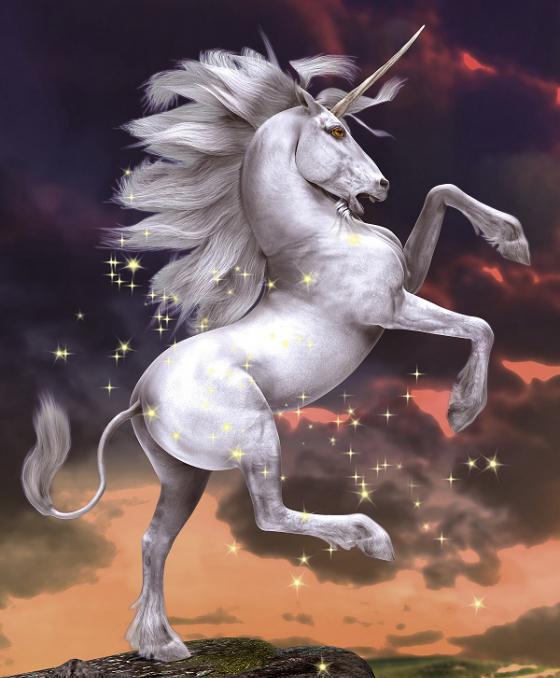
A hymn to chastity?
During the Middle Ages, this mysterious creature was sung as a symbol of purity, nobility and chivalrous service to the Beautiful Lady. The European unicorn is a great connoisseur of female beauty. As the myths tell us, it is this weakness that hunters use, wishing to catch the beautiful beast. And this can only be done with the help of a beautiful chaste maiden. Attracted by her beauty (and some manuscripts also note, as if in passing, that for greater effect the maiden must be naked), the unicorn falls asleep on the lap of the beauty. This is where the hunters succeed in captivating the fairy-tale animal. This legend in different variations existed in the Middle Ages in poetry, novels of chivalry, and fine art.


Stained-glass windows and sculptures in medieval churches and cathedrals often depict scenes with the mythical unicorn. Could it be that medieval priests patronized the development of rather racy themes in art? Not at all! They simply interpreted the legend of the unicorn as a major gospel subject. The fantastic unicorn appears as the incarnation of Christ, the horn signifying his connection with God the Father, as well as the life-giving cross. The Immaculate Virgin, of course, is a symbol of the Virgin Mary. This interpretation of the image of the unicorn runs not only through all theological treatises, but also through most medieval bestiaries - a collection of information about animals that explains their symbolic meaning. Thus a romantic legend gives way to yet another moralizing parable, it must be said, very unsuccessfully combined with the ancient mythological theme.
What does the unicorn mean as a symbol?
The legendary white horse or pony with one horn is a symbol of purity and innocence in European mythology. Only a virgin could catch and tame him. What is the meaning of the symbol?
- Protection. The unicorn is the protector and patron of all virgins. Its horn has magical healing powers and was a popular ingredient in medieval medicines. It was a powerful antidote and defense against evil.
- Virtue. The white unicorn is a symbol of dignity, chastity and purity.
- Love and harmony. Unicorns are associated with the light of the moon, love, harmony and understanding. In medieval Europe, this gentle creature stood in opposition to the lion, which represented a more violent solar influence.
- Another meaning of the symbol is associated with courage, strength, and sometimes cruelty.
Meaning of tattoos for girls
For women, the unicorn is a special sign. It is a symbol that any unbridled power bows before a pure and innocent soul. Just as the horse submits to the gaze of a meek girl. Therefore, the unicorn tattoo emphasizes the extraordinary inner strength of a fragile woman, the purity of her soul.
Girls like a bright drawing. Unicorn, embraced by flame or entwined with flowers, performed in lush stand out shades emphasizes spiritual and physical perfection.
A unicorn with wings has another meaning. It is a beautiful creature that can stand up for itself, to fight back against the enemy.
Unicorns in heraldry
The unicorn is also a prominent and significant figure in heraldic symbolism and appears, as a rule, with a spiral horn of red, black or any other color.
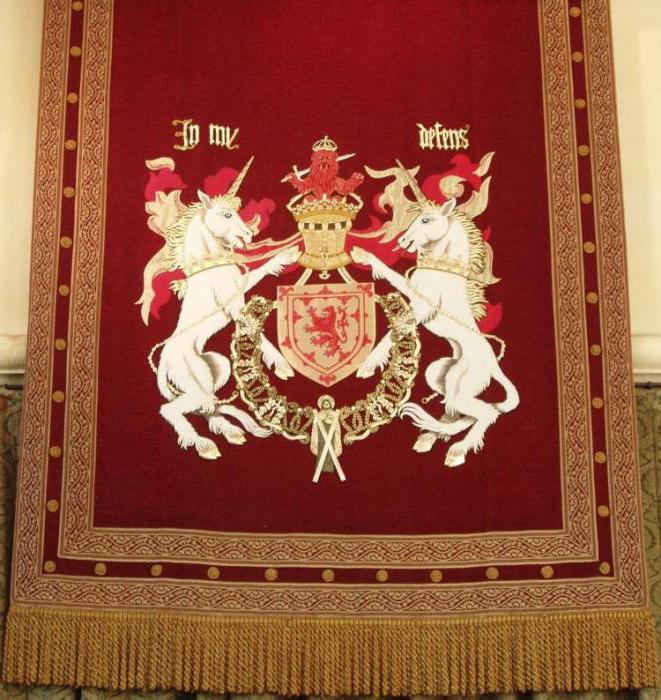

The unicorn in 15th-century heraldry is profiled with the tail of a lion and hooves of a goat, symbolizing the removal of the shackles of slavery. This was instigated by the unicorn's sacred status in medieval times. Becoming more refined, it was associated with the attributes of Christ, the Holy Spirit and the Virgin Mary.
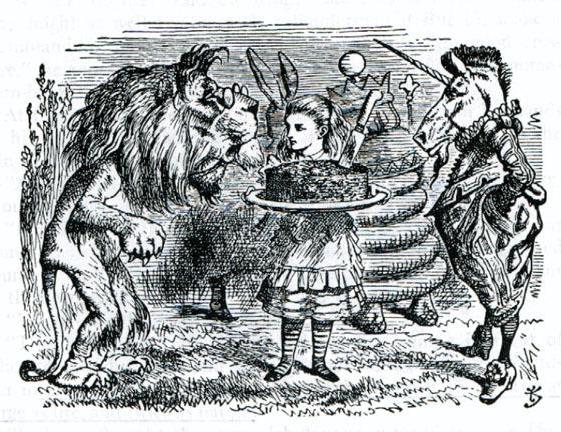

These solitary beings represented the model of monastic life. The connection with the Holy Spirit made them a symbol of mysticism and spiritual values. In Scotland, two unicorns are depicted on the royal coat of arms, the British coat of arms displays a unicorn with a lion.
The unicorn is a symbol of magic its magical powers are also legendary. #6/Mythical creatures: The Unicorn
Dedicated to my favorite fighting unicorn, a faithful companion, comrade, my dear bunny and beautiful girl! :gift_heart:
Everyone probably knows about unicorns. They are popular in all artistic manifestations of mankind. But maybe someone can learn something new for themselves.Potapalas rustled Wikipedia ... but no Wikipedia is too stingy with information, because today came to the aid of site FB.ru :
"The unicorn is one of the very few mythological creatures that are considered beneficial in almost all traditions. In modern terms, it is simply a mysterious beautiful horse with one horn. The traditional unicorn is a symbol that is represented somewhat differently, with a goat's beard, a lion's tail, and split hooves.
Unicorns occupy a place of honor in Greek mythology, Chinese traditions, in the art of the Indus Valley and India. Greek writers, including Pliny the Elder and Aristotle, mention them in their writings. There are at least eight references to unicorns in the Old Testament of the Bible.
Description of Unicorns
A fragment of a description of an unknown beast made by Photius, the patriarch of Constantinople (about 810-893 AD), was once found. He writes:
"In India there are wild donkeys, as large as horses, or even larger. Their body is white, their head is dark red, their eyes are bluish, and they have a horn in their forehead that is elbow long. The lower part of the horn, about two palms from the forehead, is perfectly white, the middle part is black, and the upper part is fiery red. Those who drink from a cup made of it are resistant to seizures, epilepsy and even poison, provided they have drunk wine, water or other liquid from these cups before or after taking the poison. Their ankles are very beautiful. These animals are very strong and fast, no horse or any other animal can outrun them.
What should be the symbol
If you want to use a figure of unicorn as a talisman, keep in mind that not every statuette is suitable for this purpose. Unicorns made of fabric, fur, plastic or rubber will never become a talisman. Wooden, porcelain, plaster and ceramic figurines are not suitable for the role of talismans, even if they are very beautiful, sweet and look just like "magical". Even the most expensive unicorns made of gold and silver will forever remain only articles of precious metals.
According to feng shui, the Unicorn that will serve as a talisman should be made of semi-precious stones: jasper, carnelian, agate, amethyst, and rose quartz. The strongest talismans are made of milky white cacholong, because the color of this stone repeats the color of the unicorn. A talisman made of transparent rock crystal will work perfectly, because this stone has strong protective properties.
However, there is one catch - unicorns of a semiprecious stone are not found on sale more often than live white horses with a horn in the forehead. Such rarity increases the value of the talisman even more. If you are lucky enough to see such an exclusive article on the counter of a jewelry or souvenir store, it means that the talisman found you. In this case, buy the statuette - it will do a lot of good, protecting the house and the people living in it from evil spells.
Unicorn in Canada?
Predominantly any references to unicorns are associated with China, India and Africa, as well as trusting medieval Europe, which was characterized by a belief in fairies, goblins and dragons. So what do Canada and the unicorn have in common? Which country's symbol looks like a horse with one horn on its forehead? It is still located on the coats of arms of England and Scotland, and there are legends associated with it as well.
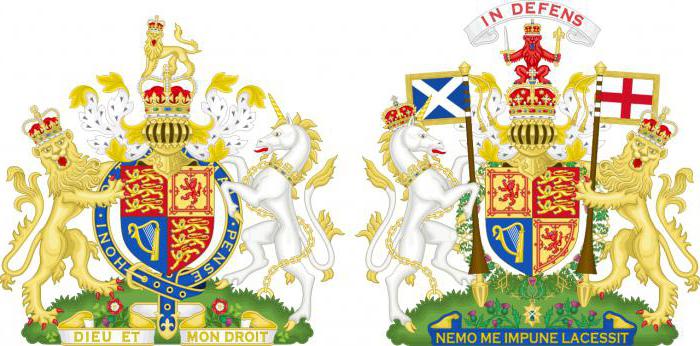

As for North America, there really were disproportionate horned creatures in the time of the dinosaurs, capable of piercing several other large animals with their horns. They include the suborder Ceratopsia (centrosaurs). These creatures resembled giant rhinoceroses, which were incredibly impulsive and violent and belonged to the Cretaceous period. As we know, more than sixty-three million years separate the last dinosaurs from primitive man. Nevertheless, early fossil discoveries have helped greatly in fueling the idea that such large, fabulous creatures as dragons and unicorns once roamed the earth.
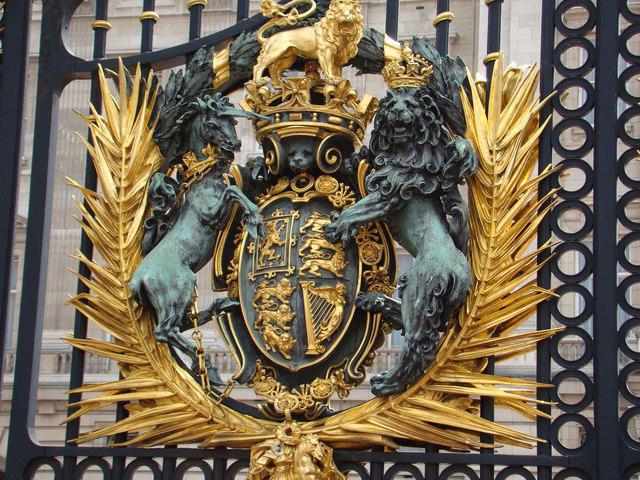

There are only two animals in nature that possess a single horn, the rhinoceros and the narwhal. The tusk of the latter can reach 3 meters. It was indeed a mythical sea horse with a horn. Found in the Arctic seas, including the northern waters of Canada, the narwhal is present in a number of Canadian coats of arms. Animals, including bulls, deer, lions, griffins, and unicorns - strong, fast, and often ferocious - are common in heraldry.
How to activate an amulet?
In order to transform a decorative figurine from a simple decoration into a real amulet, it is necessary to perform a special ritual to activate its protective properties.
It is necessary to put the figurine in a prominent place in the living room, and next to it should be installed images of different mythical creatures of the female sex, such as mermaids or fairies. Near the resulting composition should be placed several indoor plants in pots. Especially favorable to the figure of a unicorn can put beside a fern flower.
Do you like this article? Recommend it to your friends!
Source
Unicorn as a national animal
Strange as it may seem, but the official animal of Scotland is the unicorn. The fantastical character may seem like the wrong choice for the country's national animal, but that's not the case for a nation that celebrates its love of a long history of myths and legends. Since the 12th century, the unicorn has been a Scottish heraldic symbol, featured on an early form of William I's Scottish coat of arms.
Unicorns were worshipped by the ancient Babylonians, and written descriptions of them have been found in texts of ancient Persians, Romans, Greeks, and ancient Jewish scholars. In Celtic mythology, the Scottish unicorn symbolized innocence and purity, healing power, joy and even life itself, and was seen as a symbol of manliness and strength. During the reign of King James III (1460-1488) gold coins were introduced depicting a mythical creature with one horn.
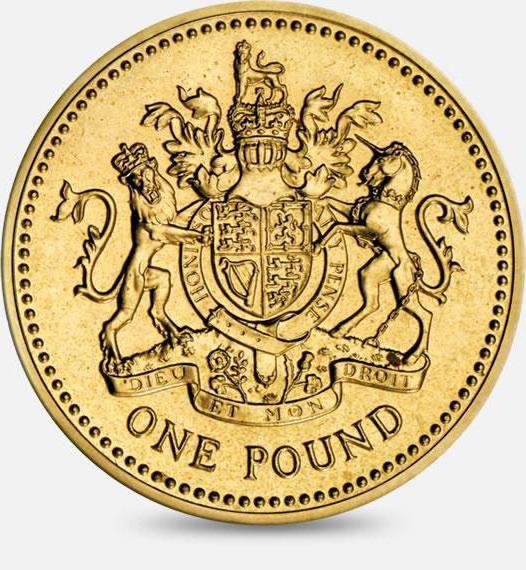

The meaning of the tattoo for men
Tattoo with the image of a unicorn is also popular among men. The mythical creature carries strength and power, which impresses brutal guys. The tattoo serves as a talisman, protects from enemies and helps in difficult situations.
The animal's horn symbolizes sovereignty, so the image is often applied to the power and strong nature, the leaders from birth.
Men can see tattoos of a horse with wings. It is Pegasus, who emerged from the union of Medusa Gorgon and Poseidon. He brings inspiration, freedom and determination. Pegasus is strong and determined because he delivered lightning and thunder for Zeus to Olympus. If a guy has a unicorn tattoo on his body, he is brave and independent and has clear goals in life.
An erotic fantasy?
What is the origin of this mysterious image, and what is more in it - Christian symbolism or frank eroticism of pagan cults? To answer this question, it is worth getting acquainted with other images close to the European unicorn.
First of all, it is the Chinese unicorn - Qi-lin, which, according to the beliefs of the ancient Chinese, descends from the sky. His appearance heralds the birth of a great and glorious man. Qi Ling is said to have appeared to Confucius' mother. In China, women kept images of Qi Ling in their chambers. This was supposed to bring glory to the future child or at least ensure the birth of a boy rather than a girl. Often the unicorn was depicted next to the moon goddess Guanyin. As we can see, the Chinese Qi lin also did not bend to female society and, characteristically, was a harbinger of good for women in childbirth.
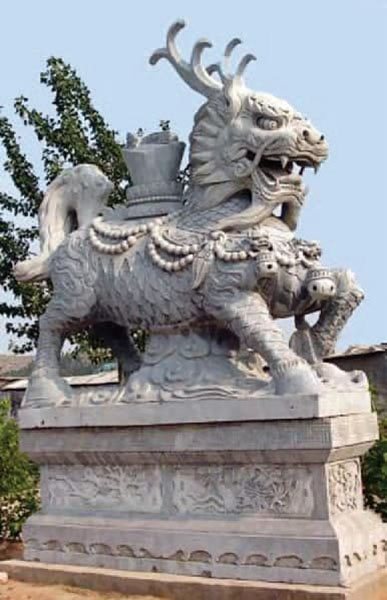

Qi lin
Syrian sources mention a unicorn-like animal called "daiya". He can also be caught only with the help of a maiden: the beast approaches her and sucks her naked breasts. At this time the girl grabs it by the horn - and the daiya becomes the prey of the hunters.
The Arabian authors do not emphasize the obligatory virginity of the huntress. Any beautiful girl can catch a unicorn.


The legend of the unicorn is by no means only a European story and is not of Christian origin at all. Its origins should be sought primarily in fertility cults, characteristic of both European and Asian pagan traditions.
According to mythology, Mother Earth and Father Sky enter into a sacred marriage, from which all life originates. The annual imitation of this marriage was a spring cycle of rituals designed to ensure the harvest. These rites were frankly erotic in nature. Their participants (often the ruler was the male deity and the priestess was the female deity) performed a ritual sexual act, which symbolized the fertilization of the Earth with the heavenly seed.
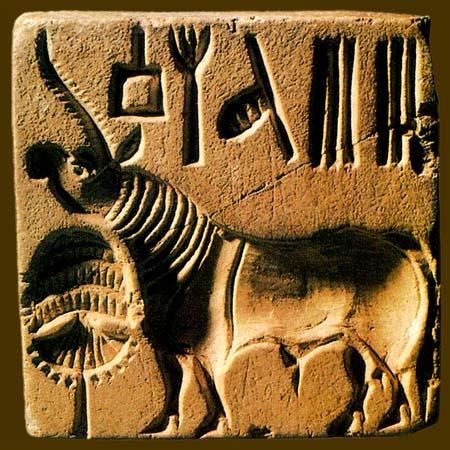

Unicorn. II millennium BC. Relief from the seal of Mohenjo-Daro
Sacred figurines depicting the male fertile organ were of great sacred significance in these rites. Such cultic phallic symbols have been discovered by archaeologists in many places in Eurasia. Some of them bear the image of the world tree. According to the researchers, the horns of animals could also carry the same symbolism. The horn in the pagan tradition was also a symbol of supreme power.
Delving deeper into the pagan tradition, we can assume that the roots of the image of the unicorn, most likely, lie in the ancient fertility cults. The animal itself could symbolize the god of fertility or his earthly incarnation - the king. The phrase of ancient manuscripts where "the unicorn comes and lies down on the bosom of a maiden" can be interpreted as a description of the ritual sexual act. It is necessary to notice that the plot of hunting a unicorn and its killing also has archaic roots. In many mythological traditions there is a story of the death and subsequent resurrection of the god of fertility (for example, Egyptian Osiris). The blood of the god spilled on the ground ensures the future harvest. Such plots are close to the ancient mysteries dedicated to the god Dionysus.
